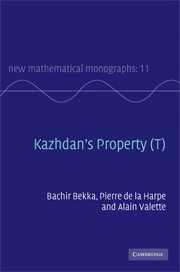Book contents
- Frontmatter
- Contents
- List of figures
- List of symbols
- Introduction
- PART I KAZHDAN'S PROPERTY (T)
- PART II BACKGROUND ON UNITARY REPRESENTATIONS
- A Unitary group representations
- B Measures on homogeneous spaces
- C Functions of positive type and GNS construction
- D Unitary Representations of locally compact abelian groups
- E Induced representations
- F Weak containment and Fell's topology
- G Amenability
- Bibliography
- Index
C - Functions of positive type and GNS construction
Published online by Cambridge University Press: 12 September 2009
- Frontmatter
- Contents
- List of figures
- List of symbols
- Introduction
- PART I KAZHDAN'S PROPERTY (T)
- PART II BACKGROUND ON UNITARY REPRESENTATIONS
- A Unitary group representations
- B Measures on homogeneous spaces
- C Functions of positive type and GNS construction
- D Unitary Representations of locally compact abelian groups
- E Induced representations
- F Weak containment and Fell's topology
- G Amenability
- Bibliography
- Index
Summary
Two of the most important notions for unitary group representations are functions of positive type and induced representations, defined respectively in the present appendix and in Appendix E.
We first discuss two kinds of kernels on a topological space X: those of positive type and those conditionally of negative type; the crucial difference is the presence or not of “conditionally”, whereas the difference between “positive” and “negative” is only a matter of sign convention. For each of these two types of kernels, there is a so-called GNS construction (for Gelfand, Naimark, and Segal) which shows how kernels are simply related to appropriate mappings of X to Hilbert spaces. Moreover, a theorem of Schoenberg establishes a relation between the two types of kernels.
A function φ on a topological group G is of positive type if the kernel (g, h) ↦ φ(g−1h) is of positive type. Functions of positive type provide an efficient tool to prove some basic general results, such as the Gelfand–Raikov Theorem according to which a locally compact group has sufficiently many irreducible unitary representations to separate its points.
- Type
- Chapter
- Information
- Kazhdan's Property (T) , pp. 340 - 368Publisher: Cambridge University PressPrint publication year: 2008



